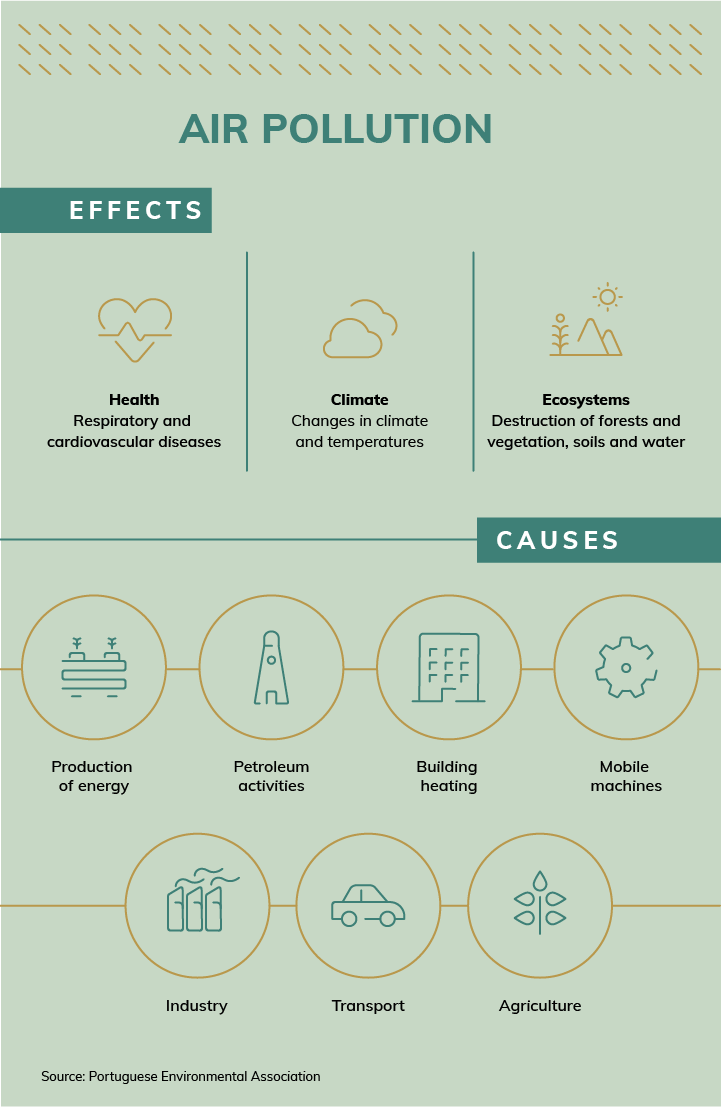Air quality
According to the World Health Organization (WHO), every year, 4.2 million people die as a result of continued exposure to air pollution. Another 3.8 million suffer the same from cooking or heating-related smoke. Lung, cardiovascular and stroke diseases, caused or aggravated by pollution, are the main causes of these numbers. 91% of people live in places with a concentration of pollutants in the air above that recommended by the WHO, particularly in less developed regions or with greater urban and industrial pressure.
Air Quality is extremely important for a healthy life, but also for the sustainability of the entire planet. By setting the 17 Sustainable Development Goals (SDGs) to 2030, the United Nations has not inscribed Air Quality as one of them. The reason is simple: this is an issue that cuts across several SDGs, ever present in the strategy of countless goals. Health and Wellness, Access to Energy,Sustainable Cities, Climate Change and Global Partnerships are the main goals of the UN, which include efforts to improve Air Quality in general and to fight pollution, whether through greenhouse gas emissions or the presence of polluting particles in the atmosphere.
In 2018, WHO's general director, Tedros Ghebreyesus, referred to air pollution as “the new tobacco”, defining it as a “silent public health emergency”, to which “no one, rich or poor, can escape”. And even though the effects of the Covid-19 pandemic have momentarily reduced pollution levels globally - and we were surprised by stories of wild animals circulating in cities - a rapid economic and industrial recovery of many sectors may have, in the immediate, even more harmful effects on the air that we breathe. It is worth remembering that one of the most used items to fight the progression of Covid-19 - the protective mask - has been part of everyday life in many countries for decades, especially in Asia.
Atmospheric pollution can have natural causes, such as volcanoes, forest fires or even earthquakes, which release polluting particles, but it is people who most affect Air Quality, mainly through transportation and agricultural or industrial activities, according to the European Environment Agency. On the other hand, rain and wind extend the effects of pollution, due to the greater dispersion of particles and through sunlight can accentuate its effects.


Whether chronic, with small effects over time, or acute, due to very high and rapid concentrations of pollutants in a specific location, the loss of Air Quality is extremely harmful to the balance of nature. And conventional transportation, powered by fossil fuels, is a major cause of pollution, especially in densely populated areas.
One euro spent for every two people
According to the WHO, the effects of air pollution on health force global public expenditures of over 4.33 billion euros every year, the equivalent of more than one euro for every two inhabitants of the planet or one third of the European Union's GDP. The UN also highlights that the 15 countries with the most greenhouse gas emissions spend 4% of their GDP on facing the impacts of air pollution.
In Portugal and in the European Union, although most of the continent has good or moderate air quality, there are several pockets of pollution, particularly in northern Italy and eastern Europe. According to the European Environmental Agency, almost all of the ten European cities with the best air quality are located in countries in the north of the continent. The exceptions are Funchal, in third position - behind Umea in Sweden and Tampere in Finland - and Salamanca, which is in 8th place. At the other extreme, the list of 323 urban areas whose pollution levels are regularly measured closes with five Polish cities, four Italian cities and one Croatian city. Nowy Sacz, in southern Poland, is the worst.
Four decades of international fighting
It was in 1979, in Geneva, that 32 countries signed the Convention on Long-Range Transboundary Atmospheric Pollution (CLRTAP), being the main international treaty that promotes Air Quality and regulates pollution. Promoted by the United Nations Economic Commission for Europe (UNECE), the convention entered into force in 1983 and, four decades later, is followed by 51 countries. The initial reason for this treaty was the confirmation that polluting particles can affect regions and countries far from where they were released or caused.
CLRTAP has been regulating the pollutants released into the atmosphere and claims that the achieved emission reductions in this way have been reduced by 40% to 80% in some types, making it possible to avoid 600 thousand deaths per year. In 2019, anniversary of the first convention, a declaration was signed that reaffirms the commitment to “enhance Air Quality, with the purpose of promoting a better environment and reducing negative impacts on human health”. Objectives up to 2030 are:
- Maximize the impact of the Air Convention;
- Ensure resources for its monitoring and planning;
- Keep the focus on better control of pollutants at the regional level;
- Support scientific activities that help define priorities and decisions;
- Improve cooperation between different governments and institutions;
- Promote an environmental approach, centered on air pollution, in policy making.
In the European Union, which represents most of the Air Convention countries, air pollution has also been an increasing focus of concern. After a first package of measures called 'Clean Air', put into practice from 2013 onwards, was followed by revisions to the regulation and analysis of the measures' impacts. More recently, regarding the European Green Agreement, the EU announced that it will be able to revise, in 2022, the directives on Air Quality. The basic idea is that “clean air is essential for health and the environment”, while the positive effect of regulatory measures on the community economy far outweighs the costs of implementing them.


Energy transition is the way forwards
As with other issues addressed by the UN SDGs, the energy transition is one of the ways to effectively fight pollution and improve Air Quality, especially in cities. This objective must be achieved by governments and companies, but also by citizens, in defining the choices they make at home and in their lives.
If transportation is one of the biggest polluters, sustainable mobility is the way forward to improve the Quality of the Air we breathe. Whether it's the exchange of a diesel or gasoline car for an electric vehicle, or the use of public transportation, shared cars and bicycles, not forgetting the walking routes, reducing pollution benefits both our health and that of those who cross our path.
EDP is committed to carbon neutrality in all its aspects, being in 2018 one of the founders of the Alliance for the Decarbonization of Tranportation, an international organization that works with the objective of taking that sector to 'zero emissions' by 2050.
Developing an agriculture that is increasingly free from pollutants, investing in an efficient industry, and reinforcing the weight and diversity of forests and green areas in cities, are other steps towards improving Air Quality. Ensuring pollution-free air, which allows people to avoid health problems and improve the balance of ecosystems, must be a common effort. So that the feeling of 'breathing fresh air' is not limited to protected areas and natural parks, but also to the downtown of major cities.

